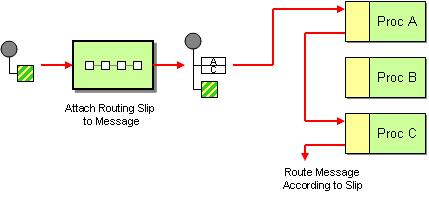Routing Slip
The Routing Slip from the EIP patterns allows you to route a message consecutively through a series of processing steps where the sequence of steps is not known at design time and can vary for each message.
Example
The following route will take any messages sent to the Apache ActiveMQ queue SomeQueue and pass them into the Routing Slip pattern.
from("activemq:SomeQueue").routingSlip("headerName");
Messages will be checked for the existance of the "headerName" header. The value of this header should be a comma-delimited list of endpoint URIs you wish the message to be routed to. The Message will be routed in a pipeline fashion (i.e. one after the other).
Note: In Camel 1.x the default header name routingSlipHeader has been @deprecated and is removed in Camel 2.0. We feel that the DSL needed to express, the header it uses to locate the destinations, directly in the DSL to not confuse readers. So the header name must be provided.
Configuration options
Here we set the header name and the URI delimiter to something different.
Using the Fluent Builders
Using the Spring XML Extensions
<camelContext id="buildRoutingSlip" xmlns="http://activemq.apache.org/camel/schema/spring">
<route>
<from uri="direct:c"/>
<routingSlip headerName="aRoutingSlipHeader" uriDelimiter="#"/>
</route>
</camelContext>
Further Examples
For further examples of this pattern in use you could look at the routing slip test cases.
Availability
This pattern is available as of Camel version 1.3.
Using This Pattern
If you would like to use this EIP Pattern then please read the Getting Started, you may also find the Architecture useful particularly the description of Endpoint and URIs. Then you could try out some of the Examples first before trying this pattern out.
